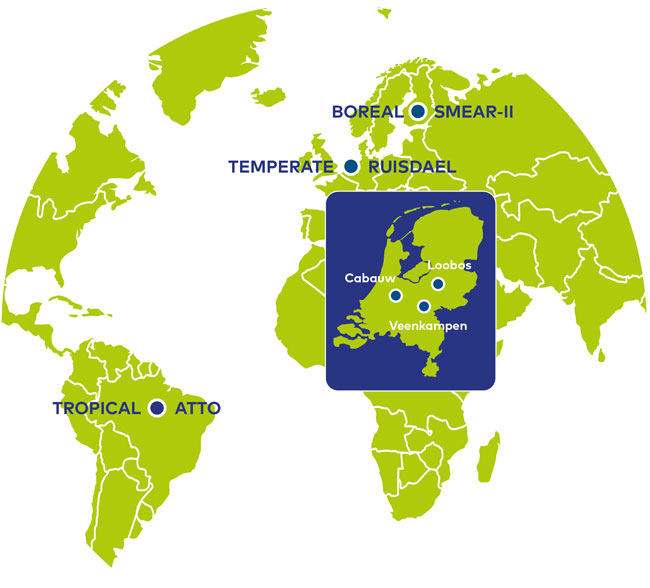ECOSYSTEMS
This novel multi-scale and multi-disciplinary approach will be applied and embedded in temperate ecosystems – grass (Cabauw, Veenkampen) and forest (Loobos)- at the Ruisdael observatory (Netherlands) as well as in a boreal forest (SMEAR-II, Finland) and a tropical rain forest (ATTO, Brazil) (see Figure). In all these ecosystems, clouds play a major role and therefore, we expect larger interactions between the ecosystems and the cloud organization. CloudRoots findings could be key to developing realistic and scalable model representations of the active role of the vegetated land in atmosphere dynamics, and vice versa, and will contribute to improving predictions of weather and climate.
The CloudRoots ecosystems: tropical, temperate and boreal, and their anchor stations

BOREAL-EUROPE
The boreal forest will complete the ecosystems understudy. Characterized by relatively moderate carbon storage and evaporative fraction, this system is also susceptible to potential changes due to more frequent droughts and heatwaves. We will make use of the smear-II observation station and use a modelling framework similar to the one proposed for the tropical and temperate ecosystems that will combine conceptual and explicit turbulent modelling.
TEMPERATE-EUROPE
The possibility of simultaneously studying the measurements taken at two grassland sites and a forest site in a temperate climate provides CloudRoots with the opportunity to relate the specifics of each ecosystem to similar cloud cycles. Special attention will be paid to the differences and relationships between water use efficiencies, evaporative fractions and cloud variables. In this ecosystem, we have the advantage of being an active partner of the Ruisdael observatory both in the collection of measurements (including the carbon and water vapor isotopologues and isofluxes) and the simulation in the DALES testbed of the three stations (see dashed line in the figure). This could provide an unprecedented level of detail for calculations and validation of the surface fluxes and cloud cycles, i.e., spatiotemporal scales of 100 meters and seconds.
TROPICAL-AMAZONIA
Characterized by strong carbon storage and strong evaporation rates, the rain forest in Amazonia is under increasing pressure due to extreme weather situations (drought, flooding) and deforestation. Our modelling and field experiments will be based around the ATTO tower. One of the main goals of CloudRoots is to determine how the partitioning of the surface fluxes controls the transition between shallow and deep convection during the wet and dry period, and in years influenced by el Niño or la Niña. Special emphasis will be placed on studying the relevance of local evaporation and moisture recycling compared to long-range sources of moisture. In the specific case of the rain forest, the height of the canopy (~30 meters) requires detailed profiles of observations and high vertical and horizontal resolution.
